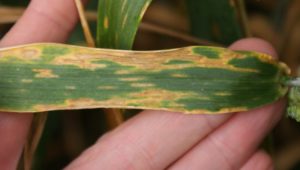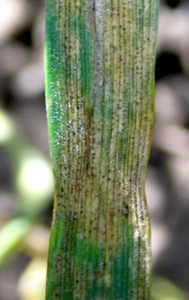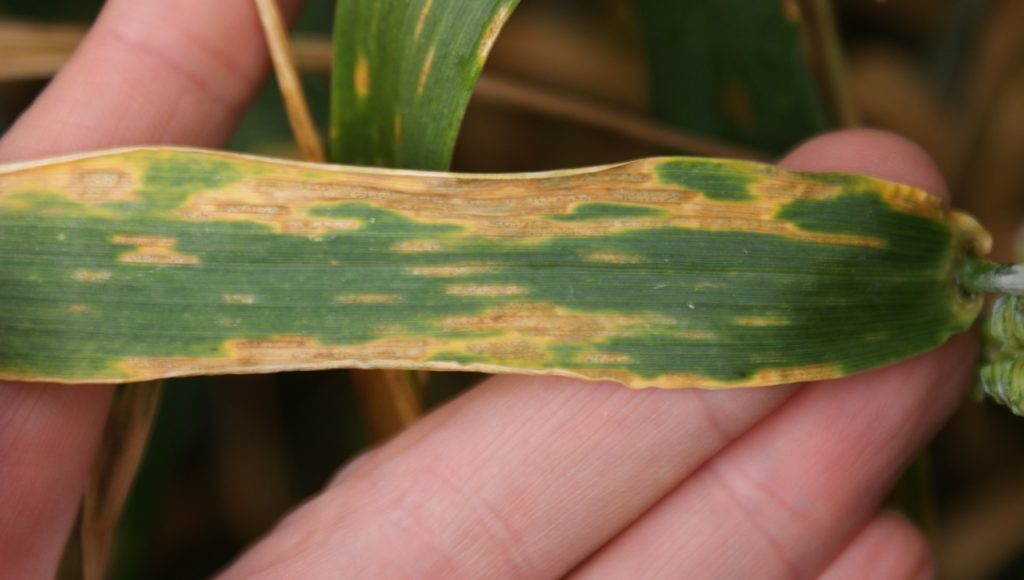Septoria – still much to learn
16 April 2018Septoria leaf blotch is such an endemic problem in Scottish wheat crops that it hardly raises an eyebrow. Its control is the main focus of spray programmes and we seem to accept that it needs three or four sprays of multiple actives to manage it and that controlling is gets harder year on year. It enjoys our damp climate and is so common in northern Europe that, shockingly, it accounts for a massive 70% of annual fungicide usage in the EU. Severe infections can cut yields by 50% in our untreated trial plots on susceptible varieties and even in treated plots where infection establishes losses can still be 5-10%.

Septoria leaf blotch symptoms on a flag leaf of wheat where it can reduce yield by 5-10% even in treated crops
But why is this disease so hard to control and so quick to adapt itself to new fungicides and new varieties? For such a well know and long standing issue people probably assume that its biology is studied to death and every nuance has been scrutinised in laboratories. In fact the reverse is true – some aspects are relatively unstudied and there are still big gaps in knowledge.. Like many other crop pathogens it has a complex and cleverly adapted life-cycle but recent advances in science have started to reveal why it is quite as adaptive as it is. Conventional wisdom on septoria would tell you that it floats in as ascopsores carried on the wind in the autumn and from there splashed up the crop until it is on those important upper leaves where it reduces the green leaf areas available for photosynthesising as well as draining plant resources for its own needs.
What is maybe less well known is quite how many infective spores it is capable of producing and how adaptable its genetic base is. Septoria produces the classic back dots of pycnidia within the plant lesions. Assuming a generation time of about 20 days allows for 6 generations per season. A moderately infected leaf could carry 400 pycnidia and these pycnidia are just the tip of the iceberg as each one can hold up to 300 spores which adds up to a massive 100 billion spores per hectare of wheat. In another twist, as well as reproducing clonally during the season it also reproduces sexually as it splashes up the leaves so that by the end of a season there are already many new strains. New insights into its genetics show that it has several additional tricks that allow it to be fast on it toes in adapting to new varieties or new fungicides. For example it has spare chromosomes and sections of genetic information that mutate more rapidly than its core genes which may speed up its ability to adapt.

Septoria produces classic pycnidia on the leaf which can give rise to a massive 100 billion spores per hecate
A conventional wisdom is that it infects the leaf and then lies latent within it until symptoms develop. In fact there is very little knowledge of that mysterious period after it has landed on a leaf but before symptoms show. What it is up to in that period isn’t well understood – it is even possible that it is still external on the leaf during a period of signalling and cross-talk with the wheat host before it ultimately succeeds in establishing itself. This strange period where septoria goes off radar makes it hard to accurately time fungicide sprays as they are only effective if used in the early part of the symptomless period which is why sprays are timed at full leaf emergence in order to get fungicides applied as protectantly as possible. A threshold approach to treating septoria which might be desirable for other pathogens won’t work with this diseases as once it is visible fungicides are ineffective.
One area where science has maybe done better to nail down this elusive pathogen is in understanding the weather conditions that promote it. It doesn’t enjoy conditions of less than minus 2 oC early in the season and this reduces the risk of later severe epidemics but it does enjoy heavy rain or 3 days or more of more moderate rain. This type of understanding gives real hope for predictive systems that will help us time sprays more cleverly.
Sign up to the FAS newsletter
Receive updates on news, events and publications from Scotland’s Farm Advisory Service

